Decentralization has long been a pillar of blockchain technology. The unique opportunity that decentralized systems present for security, transparency and quality is what makes blockchain technology so disruptive. When a system is decentralized, you create a space of permissionless ownership, free of restricted use and control from intermediaries.
It is within the nature of blockchain technology to be decentralized, but creating a decentralized system doesn’t happen by default. Creating a decentralized blockchain requires careful consideration of consensus mechanisms and an ecosystem that grows in a decentralized manner.
Consensus – The foundation for decentralization
Decentralization is built from the ground up. A system is only as decentralized as its foundation, and looking at the framework a system is developed on can help you determine whether it is decentralized or not. The core vision of Tron is to decentralize the internet, and Tron’s strong foundation has led to a successful ground-up process that lets Tron operate in accordance with that vision.
When evaluating the decentralization of a public blockchain, protocol governance is one of the key indicators of whether the blockchain is decentralized. Decentralized protocol governance is achieved at a foundational level through the decentralization of consensus. There are several different types of consensus mechanisms available for blockchains, each with its own advantages and disadvantages. The two most popular consensus mechanisms used by blockchains today are proof-of-work (PoW) and proof-of-stake (PoS).
Instead of a traditional PoS consensus mechanism, Tron uses delegated proof-of-stake (DPoS) in order to better achieve decentralization. Unlike PoS, DPoS increases the power of the community to elect nodes to approve blocks of transactions. Just as building on a blockchain doesn’t create decentralization by default, DPoS doesn’t automatically create a strong foundation for a decentralized system.
Several other popular blockchains also use the DPoS consensus mechanism, for many of the other benefits it provides. When looking at the top three validators of Tron and two other DPoS blockchains (Tezos and Cosmos), it’s apparent that not all DPoS blockchains are equally decentralized.
Top 3 Stakers and Percentage of Voting Power for Popular DPoS Blockchains (July 2022)
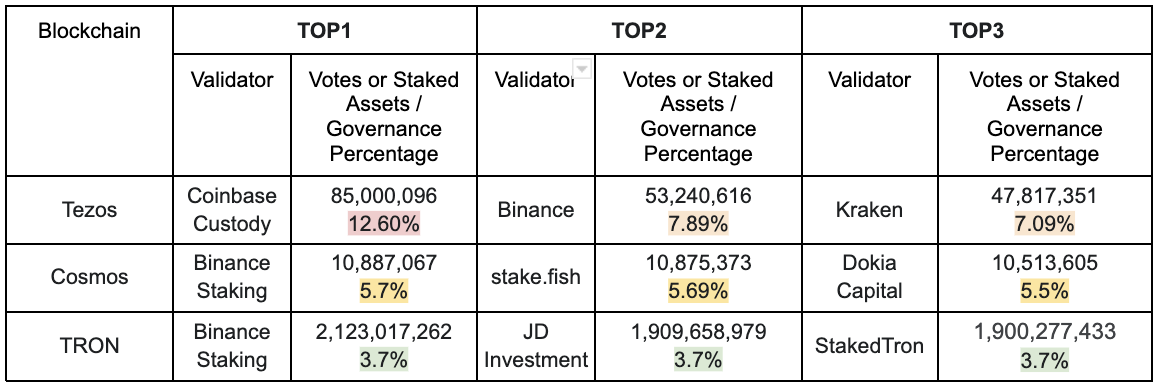
In the case of Tezos, over 25% of governance voting power is distributed to just three validators, with Coinbase receiving 12.6% of governance alone. Cosmos also suffers from the same centralization of governance power, with just under 20% of votes going to three validators. Tron, on the other hand, equally distributes power across the entire ecosystem.
The reason behind the potential for centralized consensus on Tezos and Cosmos is that governance power is determined by the number of staked assets. The power dynamic of control based on total number of assets is an all-too-familiar issue experienced in Web2 and is something Tron plans to leave behind in the future of Web3.
In the Tron ecosystem, the community elects 27 block validators to serve as “super representatives” (SR) every six hours for this vital task. These SRs are openly voted and chosen by the community of users staking their TRX, Tron's ERC-20 token, in the blockchain system. Each SR, regardless of the size of TRX staked, can cast only one vote, which effectively grants it only 3.7% of the actual voting power.
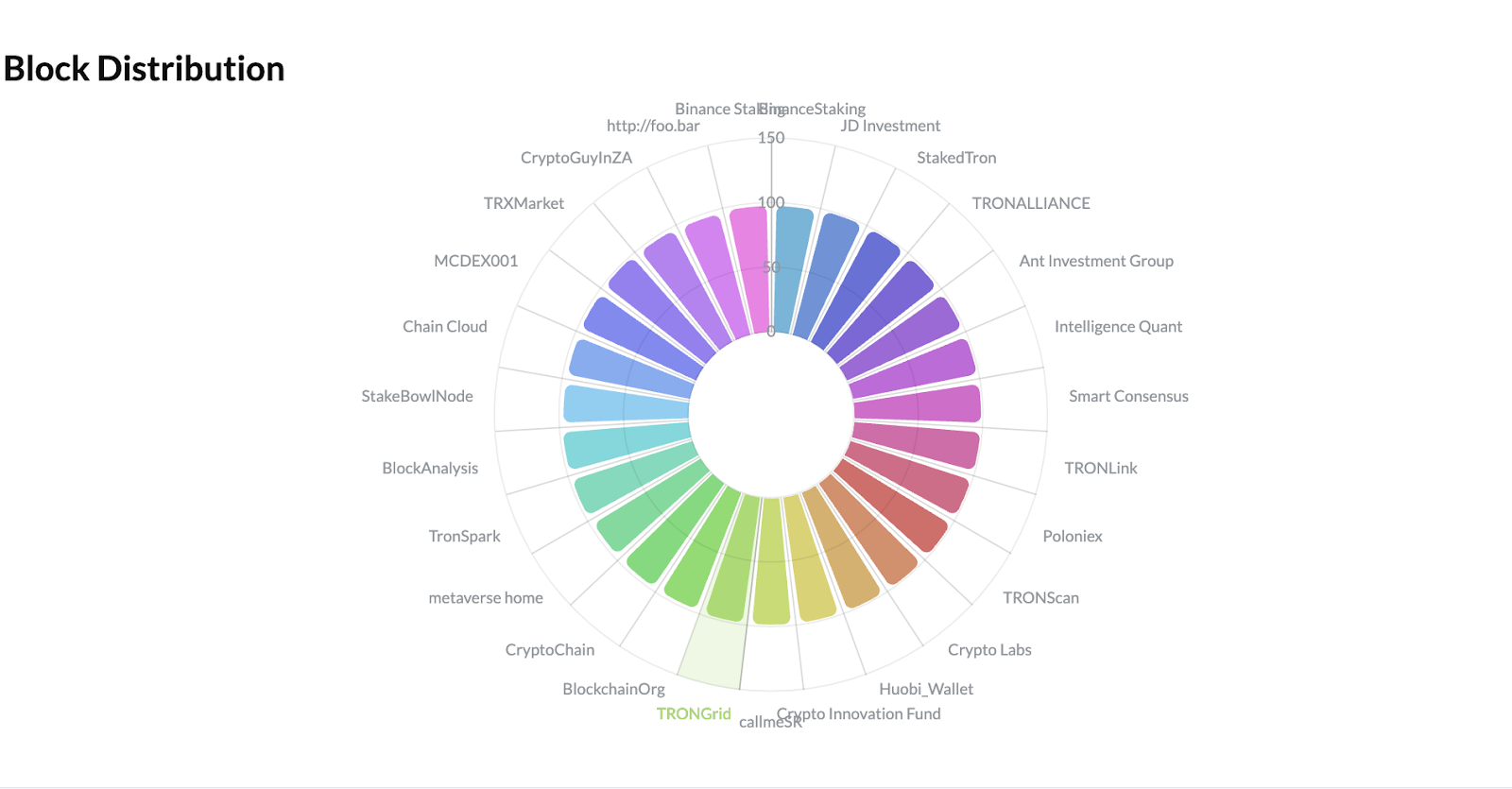
By eliminating governance power based on assets staked, Tron created an even distribution of governance power that avoids centralized control. Through Tron’s adaptation to DPoS, Tron has created a stronger foundation for decentralization than other DPoS blockchains.
Growth – The double-edged sword to decentralization
Though a significant step toward decentralization, a strong foundation is only one part of creating a decentralized system. To be decentralized, a blockchain must be decentralized both in its creation and in its implementation. Many blockchains today have slowly devolved from decentralization as their ecosystem developed. Doing so erodes blockchain’s pillar of decentralization, creating new iterations of the same traditional solutions.
Since Tron’s mainnet launch in 2018, it has continued to grow in a way that’s aligned with its core vision to decentralize the internet. Specifically, Tron’s decentralization of nodes and assets throughout its journey serve as a benchmark for what it means to be decentralized.
Decentralization of nodes
Any blockchain network is composed of distributed nodes, which form the core of the network’s infrastructure. They are therefore essential to consider in any exploration of decentralization.
It is important that nodes are distributed across not only multiple different authorities but also different countries. When nodes are confined to a specific region or country, there is an inherent risk of centralization from the local government. When considering the longevity and continuity of a system, governmental risk issues like legislation or conflict can be very disruptive.
This is why blockchains like Tron have created a community-driven, decentralized node system spread out across several different countries. Currently, around 25% of Tron’s 6,425 active nodes are running in the U.S. The other 75% of nodes are distributed across Latin America, Europe, Africa and Asia. As new regions continue to adopt Tron and similar technologies, the number of nodes in new regions grows, further strengthening decentralization.
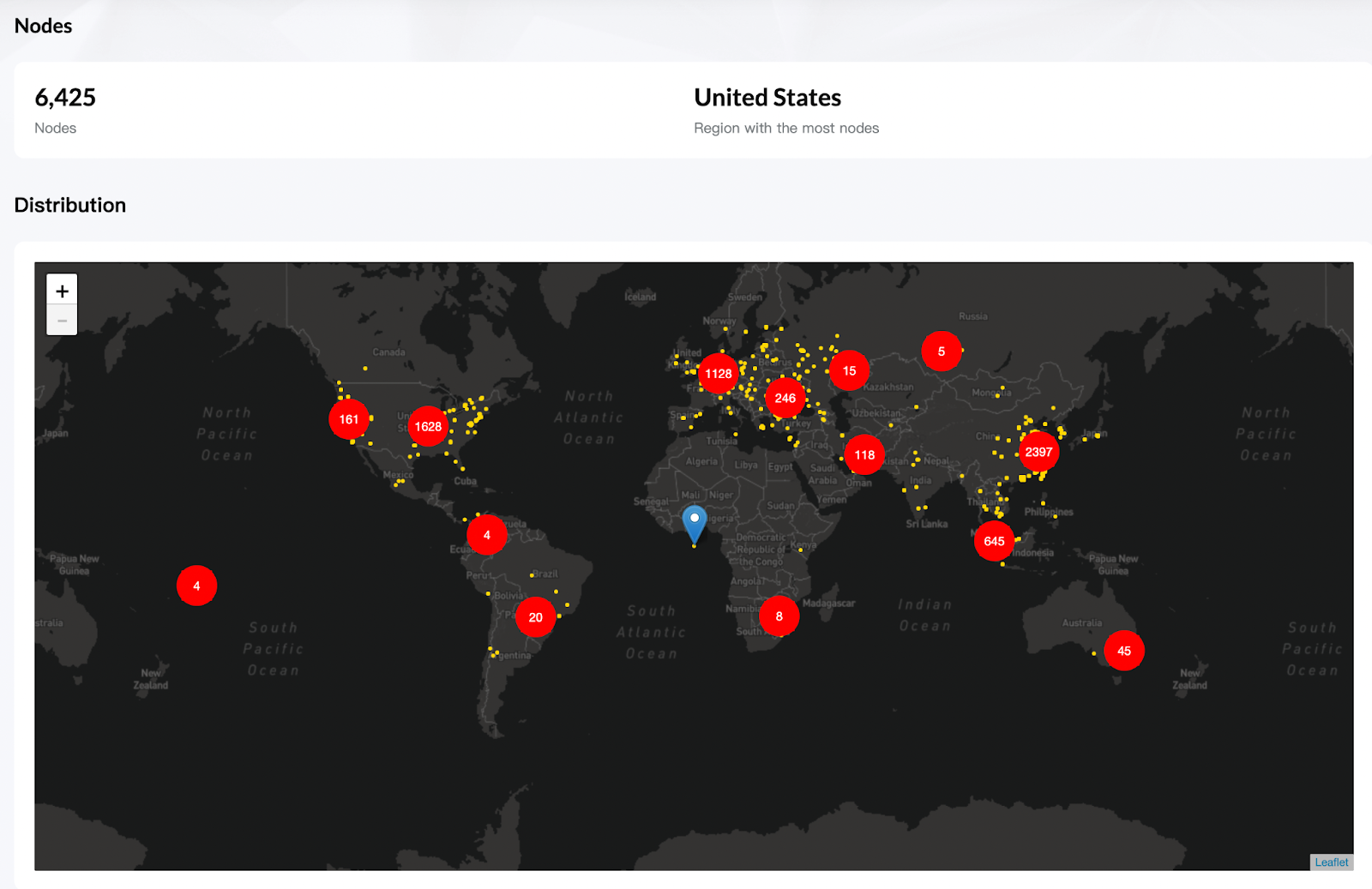
Decentralization of assets
The distribution of native tokens on a blockchain is incredibly important for a blockchain to be decentralized. Among other metrics, asset distribution in light of dapp and user growth provides the best insights in evaluating the decentralization of a public blockchain.
In terms of users, Tron has seen significant growth over the past year. As of July 1, there were a total of 26,267,487 unique wallets holding TRX, up 134% in the past year. Last month, Tron surpassed 100 million total users as it celebrated the fourth anniversary of its mainnet launch. Tron has also seen significant growth in the number of smart contracts being implemented. According to DappRadar, there are currently 1402 dapps within the Tron ecosystem. Initiatives like the Tron Grand Hackathon have supported ecosystem growth and helped empower community-led projects and solutions to build on Tron.
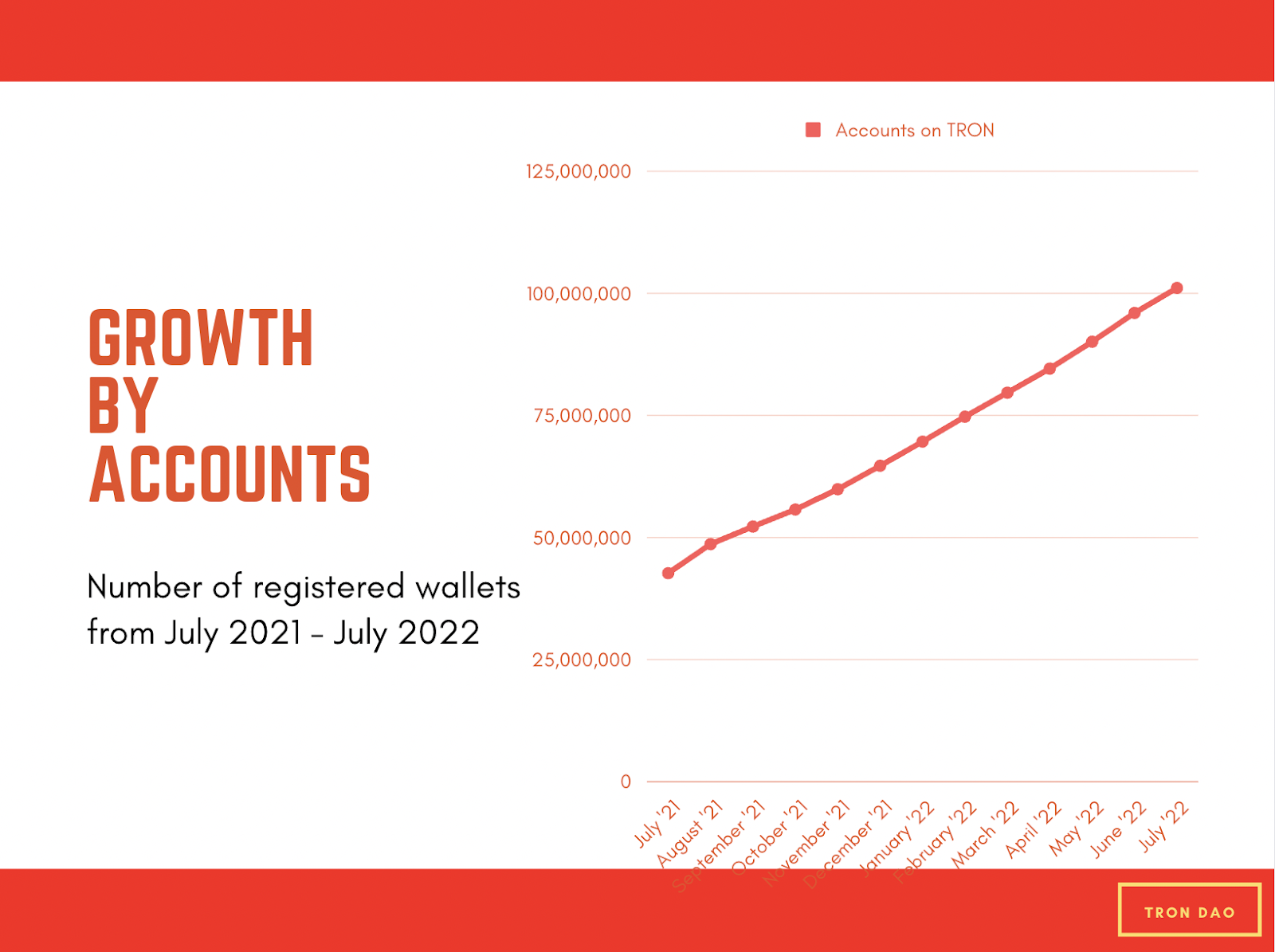
In light of the continued adoption of Tron, it’s important to look at the distribution of TRX to determine whether the blockchain is maintaining its decentralization.
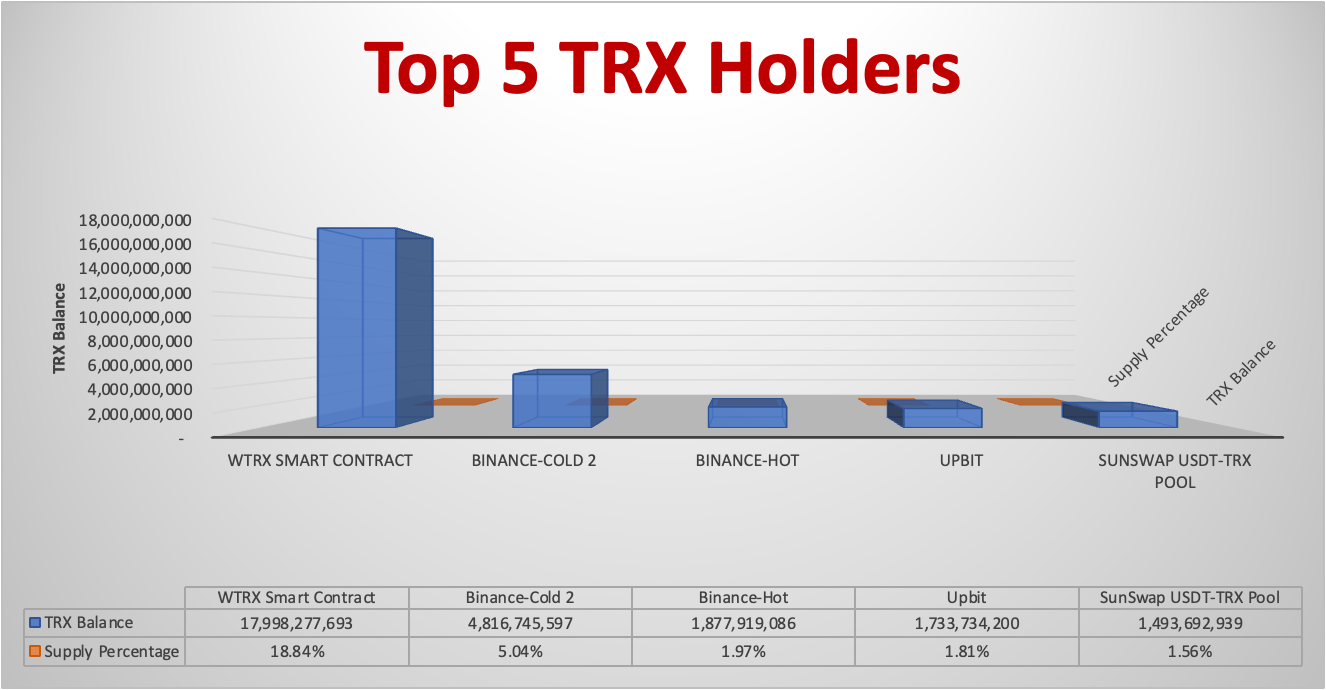
The highest concentration of TRX is contained in the top five wallets, each consisting of +1.5% of the total supply of TRX, which doesn’t seem great. However, a closer look at these top five wallets shows that the major concentration of TRX belongs to autonomous and permissionless smart contracts and cryptocurrency exchanges. Specifically:
- WTRX (smart contract) – Wrapped TRX used by smart contracts across the Tron DeFi (decentralized finance) ecosystem.
- Binance cold storage (exchange)
- Binance hot wallet (exchange)
- Upbit (exchange)
- USDT-TRX (smart contract) – SunSwap USDT-TRX pool
Concentration of these wallets isn’t necessarily a bad thing. In fact, when coupled with strong growth among users, smart contracts, and dapps, this becomes more of a testament to growth than it does centralization. As explained earlier in this breakdown, the DPoS mechanism that powers Tron allows users to pool their tokens together and vote on the delegate (super representative) of their choice. From a security perspective, this allows any bad actors to be voted out of the SR role and trustworthy SRs to be voted in. Put differently, as the Tron community continues to grow, the blockchain’s voting structure becomes increasingly more decentralized.
Growth can be a double-edged sword for decentralization on many blockchains. On the one hand, the growth of users, smart contracts, and dapps can lead to a larger community of builders and network participants. On the other, asset distribution and resource-intensive smart contracts pose a threat to the decentralization of the entire blockchain. Stemming from its strong decentralized foundation and core belief in a decentralized internet, Tron has enjoyed the positives of growth, all while improving its decentralization.
DISCLOSURE
Please note that our privacy policy, terms of use, cookies, and do not sell my personal information has been updated.
The leader in news and information on cryptocurrency, digital assets and the future of money, CoinDesk is a media outlet that strives for the highest journalistic standards and abides by a strict set of editorial policies. CoinDesk is an independent operating subsidiary of Digital Currency Group, which invests in cryptocurrencies and blockchain startups. As part of their compensation, certain CoinDesk employees, including editorial employees, may receive exposure to DCG equity in the form of stock appreciation rights, which vest over a multi-year period. CoinDesk journalists are not allowed to purchase stock outright in DCG.

:format(jpg)/cloudfront-us-east-1.images.arcpublishing.com/coindesk/XRNO4ECH5VHIPKK6ZPZQW6X7DE.jpg)
